Welcome to Antique
"Antique: Where the Mountains Meet the Sea"
Coming from an island once shrouded with mystery, the province of Antique is truly a curios place to visit. Not only is the old notion banished from from many people's beliefs, but it also paved way to ideas that will make the tourists flock this place in a heartbeat.
Understanding Antique
Antique was one of the three "Sakups" or districts of Panay before Spanish colonizers arrived on the islands. The province was known at that time as "Hantik", which was the name of the large red ants found on the island. The Spanish chroniclers, however, were influenced by the French when they recorded the name as "Hantique", and later established the formal name "Antique" after removing the "h". Unlike the English term, "Antique", the province's name is pronounced "ahn-tee-keh."
Antique was one of the three "Sakups" or districts of Panay before Spanish colonizers arrived on the islands. The province was known at that time as "Hantik", which was the name of the large red ants found on the island. The Spanish chroniclers, however, were influenced by the French when they recorded the name as "Hantique", and later established the formal name "Antique" after removing the "h". Unlike the English term, "Antique", the province's name is pronounced "ahn-tee-keh."
Located on the western section of Panay Island in Western Visayas Region (Region VI), the whole western side of Antique, from north to south, faces the Sulu Sea, blessing the province with more coastal towns than landlocked ones. The eastern portion shares border with Aklan, Capiz, and Iloilo. Antique comprises 18 municipalities, San Jose (de Buenavista) is the capital and also the most populous. Aside from the rugged terrains, inland natural wonders, beaches, and islands, the province is also laden with historical sites. All these and more make Antique not just a mere side trip or day tour attraction from its other well-known neighboring provinces but a truly worthy tourist destination.
Antique got its tagline "Where the mountains meet the sea" because of the relatively short distance between its mountains and its coast, which lies parallel to it. Just like its highland attractions, there's absolutely a lot to explore in Antique's long coastal area aside from providing an unobstructed view of the sunset. On the souhern most tip of Antique is Nogas Island, an uninhabited 26-hectare marine and bird sanctuary.
According to oral history, related as the legend of Maragtas, Antique is believed to be the landing site of ten Bornean Datus who escaped persecution from Sri-Vishaya, a Hindu-Malay empire that existed from the 7th to the 14th century in Borneo and Sumatra. There they met the Negrito/Ati (earliest settlers of Panay) chieftain Marikudo. They bought the island from the chieftain for a golden saduk (headpiece or helmet), and a golden necklace, among other gifts, the event is known as the "Barter of Panay". The Negritos then retreated to the mountains, while the Borneans settled in the lowlands. Today, the landing is commemorated every year in Antique in the Binirayan festival on the month of April with highlights on April 27 to 29.
More info about Antique:
- Location: Antique is part of Panay Island, which is in Western Visayas, the Philippines.
- Language: Kinaray-a and Hiligaynon. Most of the Antiqueños can also speak and understand Tagalog and English.
- Currency: Philippine peso (PHP, ₱). PHP 100 is around USD 1.91, EUR 1.70, or SGD 2.60 (as of May 2019).
- Mode of payment: Cash is preferred. As of writing, most of the banks, including major ones like BPI, BDO, Metrobank, PNB, DBP, and Chinabank, are located in San Jose, therefore ATMs are concentrated in the capital town. Robinson’s Place and Gaisano Grand Mall also have ATMs. Be sure to bring enough cash with you before going to remote areas.
History
Covering a narrow strip of rugged land all along the western coast of Panay Island from north to south is the province of Antique. Though the smallest of the three provinces that make up the island of Panay and reputedly one of the smallest in the archipelago, it has a rich, colorful history. On its mountainous terrain and narrow coastal plains and in the turbulent Sulu Sea that washed its shores had taken place historical events of far-reaching national significance.
The story of this province and how it got its present name goes back several hundred years before the coming of the Spaniards to our country or specifically to the period of the second wave of Malayan migration to the Philippines which took place from the first to the thirteenth century A. D. or when the might of Sri-Vishayan empire held sway in the Orient. Traditions as well as early written accounts has it that on or about the first half of the thirteenth century a group of ten datus from Bornay (Borneo) escaping from the tyrannical rule of Sultan Makatunao of Borneo sailed from Brunei in search for a land where they could live a much freer life. Hiding in large sailing vessels called “balangay” or “Biniday” they followed the coastline of Paragwa (Palawan) until they sighted the island of Panay. Upon reaching the southeastern tip of the island they sailed shoreward, entered the Sirawagan River and landed on the bank of Lake Audona not far from the site of Barrio Sinogbohan in San Joaquin, Iloilo. It is believed that the Bornean datus were guided by one who had visited the island in previous voyages. Heading the expedition was Datu Puti who at that time was minister to Sultan Makatunao. The other lesser datus with him were Datu Sumakwel, Datu Bankaya, Datu Paiburong, Datu Paduhinog, Datu Dumlagdog, Datu Dumangsol, Datu Dumangsil, Datu Lubay and Datu Balkasusa. With them came too some women, the most prominent of whom Pinang-pangan, wife of Datu Puti, Pabulana, wife of Datu Paiburong, Capinangan, wife of Datu Sumakwel, Datreng, wife of Dumangsol and Ilohay Tanayan and Ilohay Solinyon, beautiful daughters of Paiburong, and their followers and slaves. At that time Panay Island which was then called Aninipaywas peopled mostly by Negritos under their ruler called Marikudo and his wife Maniwantiwan. Upon their landing, the Malayan saw a Negrito fishing in the lake. Through him the Borneans came to know who was their chief and where he was having his kingdom. Later during the day the datus followed by their men and slaves, proceeded to Sinogbuhan where they met the Negritos under Marikudo. The Borneans immediately made known their desire to befriend the natives and their intention to settle permanently in the island, possibly on the site of Marikudo’s settlement. Marikudo told Datu Puti to wait for a few days for he would talk the matter yet with his men and that he would just send a messenger to Datu Puti when he would be ready. The men of Marikudo consented to the proposition without much discussion. They reasoned out that anyway the land was too wide for them to till and occupy and that they preferred to live in the mountains where they had their kaingin and which were far from the shore and therefore, free from the plundering of sea pirates that visited the place occasionally. Marikudo then made preparations. He caused his men to hunt for deer and wild pigs, to catch crabs and fish, and to gather edible shells. He also ordered all his men to be present during the return of the Borneans and to bring musical instruments with them. After a few days, when everything was ready, he invited the Borneans to come to their place. The Borneans came in their best attire. A great feast followed replete with eating, drinking and dancing. The Borneans showed their “sinulog” and “dinapay”. Similarly the Negritos also showed their “urokay” and the “undok-undok”. The feasting ended and the terms of the purchase of Panay were discussed. Datu Puti inquired about the extent of the territory owned by the Negritos, whereupon one of the Negritos informed him that should a man go around the island following the shore, leaving the place just after planting rice, he would be back just on time for the harvest. Marikudo in turn asked how much were the Malays willing to pay for the land. Datu Puti then sent for the “gold sadok” (tropical headwear) and a gold batiya (wash basin) which he intended to give as payment. Marikudo placed the gold sadok on his head and began to dance. On the other hand, Maniwantiwan began to cry and insisted that she too get something for herself from the purchase; otherwise she would not consent to it. Datu Puti then prevailed upon Pinangpangan, his wife, to give her gold necklace that touched the ground to Maniwantiwan, instead of the gold batiya. The Negritos promised to give in addition, one tabungos (large basket made of woven split bamboos), one large wild pig with protruding teeth, and a gray, cross-eyed deer. The Malays also gave the Negritos some axes, beads, and other articles. The Negritos were never able to make good their promise. Soncuya believed that Panay cost according to our present monetary standard P57,790.00. After the Negritos had moved away to the mountains, the Borneans cleared the place burning all the dirty huts of the Negritos. Three days after, they moved to the new settlement with the exception of Datu Lubay, Datu Dumalugdog, Daty Paduhinog, Datu Dumangsol, with their wives, followers, and slaves, who remained and later went somewhere else where the rest did not know. Datu Paiburong, with his wife and men went to settle in a place called “Lanag”, somewhere in Iloilo. Three days after they had moved to Sinogbuhan, Datu Puti invited his men to make offerings to their chief god, Bululacaw and requested their chief priest, Bangutbanua to ask of their god, counsel as to the best place for them to live. Bangutbanua did as he was told and came out later with the pronouncements that in the southwestern part of the island was the best place for a permanent settlement. Datu Puti ordered Datu Sumakwel to see the place. Datu Sumakwel reported to Datu Puti that the place had a wide fertile plain and abounds with fish. Datu Puti then urged Datu Sumakwel not to stay long in Sinogbuhan but to transfer to Malandog immediately. Three days after the return of Sumakwel from Malandog, Datu Puti informed his men of his desire to go back to Borneo. He gathered his men around him and gave them his last advice. In his absence, he appointed Datu Sumakwel head datu and urged them to respect him as such. Then one night Datu Puti sailed away accompanied by Datu Dumangsil, Datu Balkasusa, their wives, followers and slaves. Hardly had Datu Puti left Panay when Datu Sumakwel effected their transfer to Malandog that had been selected previously as the site for the permanent settlement. In due time the Bornean settlement at Malandog grew. In the course of their exploration around the new place, they came upon habitats of large ants called “hamtichamtic” and they called the place Hamtik. Within a short period the Malayan settlement in Malandog spread out and the population came to be centered in Hamtik. Then about a year after their transfer to Malandog the seven datus came together to a meeting to discuss the establishment of a government among themselves and to provide for their common protection. In that meeting they agreed among other things to name the island Madya-as from the name of one of the highest peaks in the island where their superior god Bulalacaw was supposed to have his abode. They also agreed to divide the island into three sakops; namely, Hamtik (Antique) to be ruled by Datu Sumakwel, Aklan (Capiz) to be ruled by Datu Bankaya, and Irong-Irong (Iloilo) to be ruled by Datu Paiburong. Sumakwel was to be respected as the chief datu. Datus Lubay, Dumalogdog, Dumangsol and Paduhinog were to remain in Hamtik with Datu Sumakwel and were to serve as advisers to him in his capacity as overlord of Panay. Thus the whole province came to be known and called Hamtik ever since then until the coming of the Spaniards. From Hamtik Datu Sumakwel ruled the island of Panay and Antique became the first important seat of Malayan civilization in the Philippines. As early as 1565 the Spaniards under the leadership of Martin de Goiti explored Panay Island. It was not until 1569, however, that Legaspi finally moved his headquarters to this island in order to avoid the attacks of the Portuguese under Pereira. It was during this period that the Spaniards first visited the place. Hamtik was then already a flourishing Malayan settlement. From Oton the Spaniards gradually exerted their control and influence over the whole island and by the end of the 16th century, Panay was under their control. The Spaniards called the place Antique, a name derived from the Malayan name Hamtik. The Malayan settlement in Hamtik then became the first capital.
The story of this province and how it got its present name goes back several hundred years before the coming of the Spaniards to our country or specifically to the period of the second wave of Malayan migration to the Philippines which took place from the first to the thirteenth century A. D. or when the might of Sri-Vishayan empire held sway in the Orient. Traditions as well as early written accounts has it that on or about the first half of the thirteenth century a group of ten datus from Bornay (Borneo) escaping from the tyrannical rule of Sultan Makatunao of Borneo sailed from Brunei in search for a land where they could live a much freer life. Hiding in large sailing vessels called “balangay” or “Biniday” they followed the coastline of Paragwa (Palawan) until they sighted the island of Panay. Upon reaching the southeastern tip of the island they sailed shoreward, entered the Sirawagan River and landed on the bank of Lake Audona not far from the site of Barrio Sinogbohan in San Joaquin, Iloilo. It is believed that the Bornean datus were guided by one who had visited the island in previous voyages. Heading the expedition was Datu Puti who at that time was minister to Sultan Makatunao. The other lesser datus with him were Datu Sumakwel, Datu Bankaya, Datu Paiburong, Datu Paduhinog, Datu Dumlagdog, Datu Dumangsol, Datu Dumangsil, Datu Lubay and Datu Balkasusa. With them came too some women, the most prominent of whom Pinang-pangan, wife of Datu Puti, Pabulana, wife of Datu Paiburong, Capinangan, wife of Datu Sumakwel, Datreng, wife of Dumangsol and Ilohay Tanayan and Ilohay Solinyon, beautiful daughters of Paiburong, and their followers and slaves. At that time Panay Island which was then called Aninipaywas peopled mostly by Negritos under their ruler called Marikudo and his wife Maniwantiwan. Upon their landing, the Malayan saw a Negrito fishing in the lake. Through him the Borneans came to know who was their chief and where he was having his kingdom. Later during the day the datus followed by their men and slaves, proceeded to Sinogbuhan where they met the Negritos under Marikudo. The Borneans immediately made known their desire to befriend the natives and their intention to settle permanently in the island, possibly on the site of Marikudo’s settlement. Marikudo told Datu Puti to wait for a few days for he would talk the matter yet with his men and that he would just send a messenger to Datu Puti when he would be ready. The men of Marikudo consented to the proposition without much discussion. They reasoned out that anyway the land was too wide for them to till and occupy and that they preferred to live in the mountains where they had their kaingin and which were far from the shore and therefore, free from the plundering of sea pirates that visited the place occasionally. Marikudo then made preparations. He caused his men to hunt for deer and wild pigs, to catch crabs and fish, and to gather edible shells. He also ordered all his men to be present during the return of the Borneans and to bring musical instruments with them. After a few days, when everything was ready, he invited the Borneans to come to their place. The Borneans came in their best attire. A great feast followed replete with eating, drinking and dancing. The Borneans showed their “sinulog” and “dinapay”. Similarly the Negritos also showed their “urokay” and the “undok-undok”. The feasting ended and the terms of the purchase of Panay were discussed. Datu Puti inquired about the extent of the territory owned by the Negritos, whereupon one of the Negritos informed him that should a man go around the island following the shore, leaving the place just after planting rice, he would be back just on time for the harvest. Marikudo in turn asked how much were the Malays willing to pay for the land. Datu Puti then sent for the “gold sadok” (tropical headwear) and a gold batiya (wash basin) which he intended to give as payment. Marikudo placed the gold sadok on his head and began to dance. On the other hand, Maniwantiwan began to cry and insisted that she too get something for herself from the purchase; otherwise she would not consent to it. Datu Puti then prevailed upon Pinangpangan, his wife, to give her gold necklace that touched the ground to Maniwantiwan, instead of the gold batiya. The Negritos promised to give in addition, one tabungos (large basket made of woven split bamboos), one large wild pig with protruding teeth, and a gray, cross-eyed deer. The Malays also gave the Negritos some axes, beads, and other articles. The Negritos were never able to make good their promise. Soncuya believed that Panay cost according to our present monetary standard P57,790.00. After the Negritos had moved away to the mountains, the Borneans cleared the place burning all the dirty huts of the Negritos. Three days after, they moved to the new settlement with the exception of Datu Lubay, Datu Dumalugdog, Daty Paduhinog, Datu Dumangsol, with their wives, followers, and slaves, who remained and later went somewhere else where the rest did not know. Datu Paiburong, with his wife and men went to settle in a place called “Lanag”, somewhere in Iloilo. Three days after they had moved to Sinogbuhan, Datu Puti invited his men to make offerings to their chief god, Bululacaw and requested their chief priest, Bangutbanua to ask of their god, counsel as to the best place for them to live. Bangutbanua did as he was told and came out later with the pronouncements that in the southwestern part of the island was the best place for a permanent settlement. Datu Puti ordered Datu Sumakwel to see the place. Datu Sumakwel reported to Datu Puti that the place had a wide fertile plain and abounds with fish. Datu Puti then urged Datu Sumakwel not to stay long in Sinogbuhan but to transfer to Malandog immediately. Three days after the return of Sumakwel from Malandog, Datu Puti informed his men of his desire to go back to Borneo. He gathered his men around him and gave them his last advice. In his absence, he appointed Datu Sumakwel head datu and urged them to respect him as such. Then one night Datu Puti sailed away accompanied by Datu Dumangsil, Datu Balkasusa, their wives, followers and slaves. Hardly had Datu Puti left Panay when Datu Sumakwel effected their transfer to Malandog that had been selected previously as the site for the permanent settlement. In due time the Bornean settlement at Malandog grew. In the course of their exploration around the new place, they came upon habitats of large ants called “hamtichamtic” and they called the place Hamtik. Within a short period the Malayan settlement in Malandog spread out and the population came to be centered in Hamtik. Then about a year after their transfer to Malandog the seven datus came together to a meeting to discuss the establishment of a government among themselves and to provide for their common protection. In that meeting they agreed among other things to name the island Madya-as from the name of one of the highest peaks in the island where their superior god Bulalacaw was supposed to have his abode. They also agreed to divide the island into three sakops; namely, Hamtik (Antique) to be ruled by Datu Sumakwel, Aklan (Capiz) to be ruled by Datu Bankaya, and Irong-Irong (Iloilo) to be ruled by Datu Paiburong. Sumakwel was to be respected as the chief datu. Datus Lubay, Dumalogdog, Dumangsol and Paduhinog were to remain in Hamtik with Datu Sumakwel and were to serve as advisers to him in his capacity as overlord of Panay. Thus the whole province came to be known and called Hamtik ever since then until the coming of the Spaniards. From Hamtik Datu Sumakwel ruled the island of Panay and Antique became the first important seat of Malayan civilization in the Philippines. As early as 1565 the Spaniards under the leadership of Martin de Goiti explored Panay Island. It was not until 1569, however, that Legaspi finally moved his headquarters to this island in order to avoid the attacks of the Portuguese under Pereira. It was during this period that the Spaniards first visited the place. Hamtik was then already a flourishing Malayan settlement. From Oton the Spaniards gradually exerted their control and influence over the whole island and by the end of the 16th century, Panay was under their control. The Spaniards called the place Antique, a name derived from the Malayan name Hamtik. The Malayan settlement in Hamtik then became the first capital.
People and Culture
The people of Antique are known to be hospitable and warm. They would always extend assistance to guests and visitors. They are seafaring, just like most of their Panay neighbors. Because Antiqueños have been isolated from other Panay dwellers by long mountain ranges, they have developed and used their own distinct language KInaray-a.
The Antiqueños are noted for their industry. They are renowned weavers throughout the Visayas. The Bugasong patadyong, a tube cotton fabric of plaid design, is highly valued because of its fineness of weaving. Piña cloth is also produced in looms throughout the province. Wine manufactured from the sap of the coconut is a cottage industry. Muscovado sugar production is also a big industry in Antique, which has become an attraction of sorts because of Antique's native delicacies derived from muscovado sugar.
The Catholic Church holds a very strong influence on Antiqueños. For centuries, the churches were the physical vanguards of the people. Piña cloth is also produced in looms throughout the province. Wine manufactured from the sap of the coconut is a cottage industry. The rugged and varied land of Antique offers visitors a variety of outdoor activities. Diving and beach enthusiasts would have a great time discovering the unspoiled islets of Antique.
Festival
Binirayan: Festival for the Antiqueños
Festival
Binirayan: Festival for the Antiqueños
Binirayan is Antique's annualfestival. Literally means, “where they landed”, recalls the story of the ten Bornean datus led by Datu Puti and Datu Sumakwel who fled from the oppressive rule of Sultan Makatunaw and their subsequent settlement in Panay in the early 15 th century. This episode in the history of our race is re-enacted through a pageant on the beaches of Malandog, Hamtic.
Celebrated annually, the festival progressed from a raucous revelry to a meaningful, albeit scripted street theater highlighted by several features: Biray , a fluvial parade, Bugal kang Antique Awards, Lin-ay kang Antique , Pasundayag , etc. Binirayan showcases local finery, a festival to see and be part of. The celebration aims to boost tourism and attracts visitors to Antique
The idea of celebrating Binirayan was pioneered by then Governor Evelio B. Javier. Under his leadership, the Antiqueños felt the need to get together to celebrate their history as a people. The festival has paved the way for the Antiqueños scattered in the different part of the country and the world to journey back to their past and trace their noble roots.
Tourists Destinations
For convenience, we grouped the list below into two: north and south.
The North’s attractions include those of Pandan, Culasi, and Tibiao municipalities. These attractions are nearer the world-famous Boracay Island in Malay, Aklan. If you are planning to explore both Antique and Boracay but got limited time to do so, you can tackle these attractions first. These attractions are also more feasible if you are entering and exiting via Kalibo International Airport or Caticlan Airport. Here are the attractions in the north.
- Kawa Hot Bath
- Tibiao Eco-Adventures Tour
- Bugtong Bato Falls
- Seco Island
- Mararison Island
- Malumpati Cold Spring
- Naranjo Water Park
- Dioso Farm
The South spans the towns San Remigio, Patnongon, San Jose de Buenavista, Hamtic, Tobias Fornier (formerly Dao), and Anini-y. If you want to explore both Iloilo and Antique, these attractions are workable especially if your gateway is either Iloilo International Airport or Antique Airport.
- Aningalan Highland Strawberry Garden
- Igbaclag Cave and Stone Castle
- Antique Heritage Tour
- Alpas (Tobias Fornier)
- Nogas Island
- Sira-an Hot Spring
KAWA HOT BATH
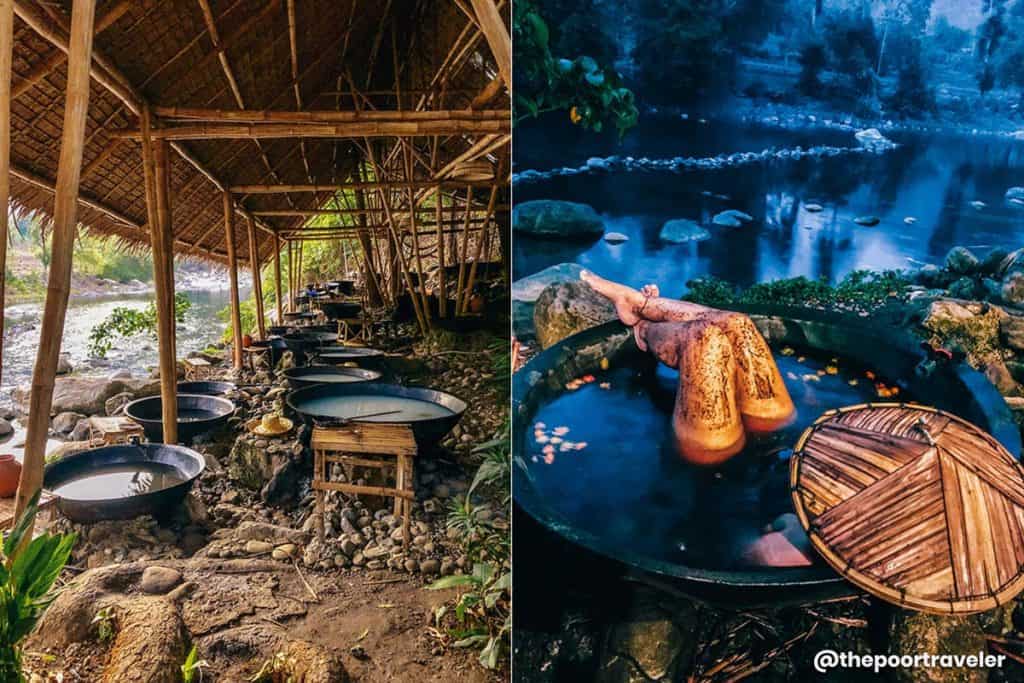
You might have come across a post on Instagram showing a person “being cooked” in a large wok (vat or cauldron) complete with all those eye-catching “ingredients” such as flowers and leaves to make it more colorful and interesting. This is Antique’s signature Kawa Hot Bath. It’s Pinoy-style hot tub.
Antique is one of the largest producers of muscovado sugar in the Philippines. After extracting the juice from the sugarcane, it is then boiled in a kawa until it reaches a certain level of thickness to produce the sugar. The kawa eventually found another purpose that benefits the tourism industry of Antique. At present, you will find a lot of places and resorts offering kawa baths. We tried ours at Calawag Mountain Resort in Tibiao where you get to choose the flavor for your bath — coffee, salt, milk, beer, and wine!
Location: Calawag Mountain Resort, Barangay Tuno, Tibiao, AntiqueCalawag Mountain Resort Kawa Bath Rates:Kawa Salt Bath – P299+/person
Kawa Milk Bath – P399+/person
Kawa Coffee Bath – P399+/person
Kawa Beer Bath – P399+/person
Kawa Wine Bath – P599+/personOther Fees:Calawag Entrance Fee – P50+/person
Lumpiga – P399+/table
Picnic Table – P399+/table
Native Gazebo – P499+/gazebo
TIBIAO ECO-ADVENTURES TOUR
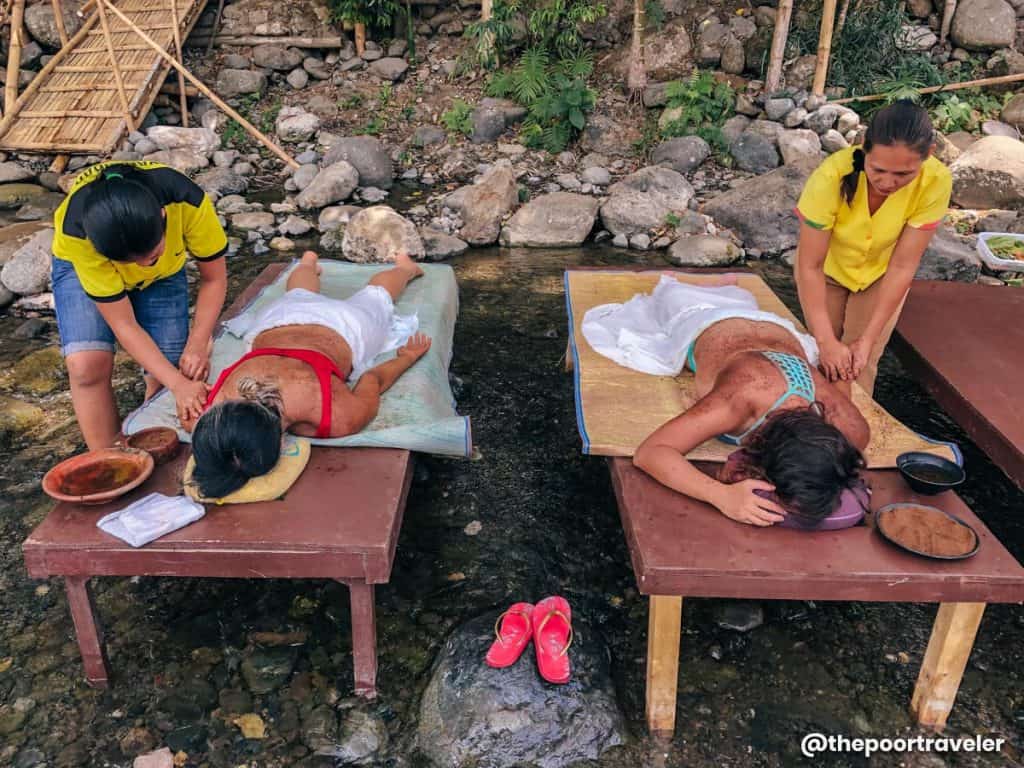
While in Tibiao, there are other things to do aside from the kawa bath. Water adventure activities are fun, especially during the right season when the cascades and rapids are strong, usually from June to October. You can do basic or extreme water tubing and extreme kayaking down Tibiao River. After the thrilling yet fun water experience, you can relax by pampering yourself with any of these — coffee body scrub, body massage, and fish spa. You can also combine water tubing with a body scrub, and capping it off with kawa bath.
Calawag Mountain Resort Rates:
Basic Water Tubing – P199+/person
Extreme Water Tubing – P499+/person
Extreme Kayaking – P899+/person
Tibiao Fish Spa – P119+ (30 minutes)Foot Massage – P249+ (30 minutes)
Coffee Body Scrub – P399+/person
Half-Body Massage – P249+ (30 minutes)
Full-Body Massage – P499+ (1 hour)Katahum Tours’ Tibiao Eco-Adventure Day Tour Package: P2,249+/person
(Minimum of two pax)
Inclusions: nature trekking, Bugtong Bato Falls, Kawa Salt Bath, Hanging Bridges, swimming and boulder jumping at Tibiao River, natural jacuzzi, bird’s nest, visit Museo de Tibiao and original branch of Tibiao Bakery, motorbike ride around Tibiao, unlimited Tibiao fish spa, Antiqueño lunch at Calawag Mountain Resort, DOT-trained eco-guide, waterfalls guide, and entrance feesNote: This is just one of the several tour packages that Katahum Tours offers for Tibiao Eco-Adventure experience.
BUGTONG BATO FALLS
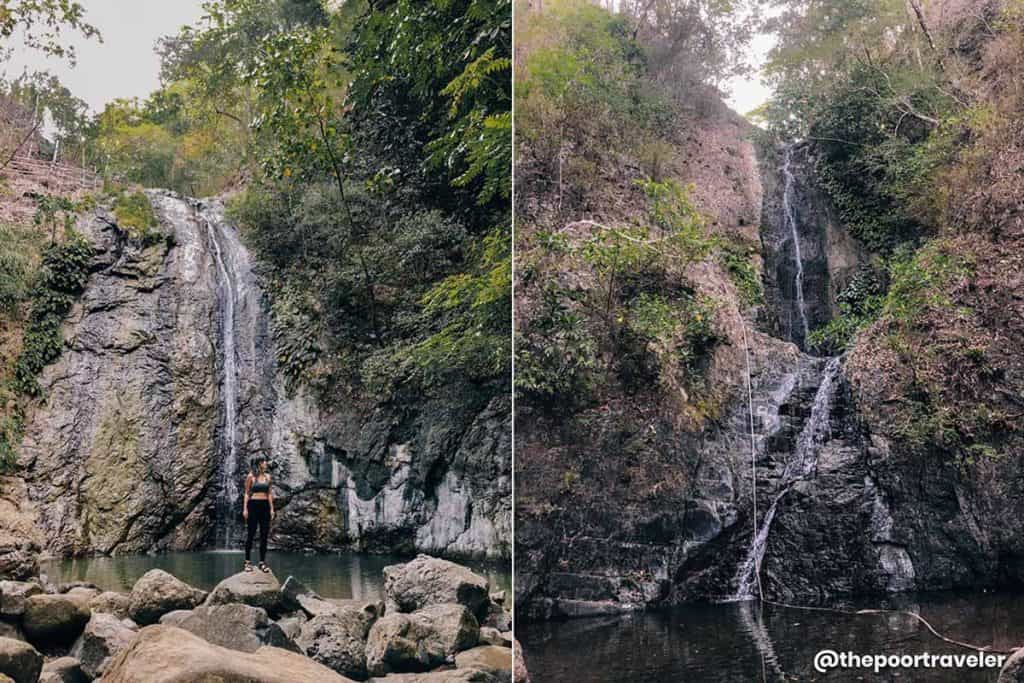
Bugtong Bato is usually included in package tours organized by travel agencies, tour operators, and hotels. The multi-layered falls, nestled at the mountainside community of Barangay Tuno in Tibiao, is one of the popular attractions in Antique. The waterfall system has seven tiers, but only three are frequented by tourists because they are the most accessible. You will pass by communities and rice paddies on the way to the waterfalls.
The first cascade can be reached after trekking for about 30 minutes from the jump-off point, which is also the registration area (landmark: barangay hall/covered court). After that, you will have to climb several steep steps to reach the second cascade. For those who want to challenge themselves, you can rappel your way up the third cascade where you can reward yourself with a cold dip in the pool. The third tier has the deepest pool and the most confined area. The best time to go is during the rainy season when the cascades are roaring, but be extra careful as trails will be muddy and slippery.
Location: Barangay Tuno, Tibiao, Antique
Registration Fee: P50/person
Guide Fee: P150-200 (maximum of 4 pax)
Calawag Mountain Resort Bugtong Bato Package: P249+/person
SECO ISLAND
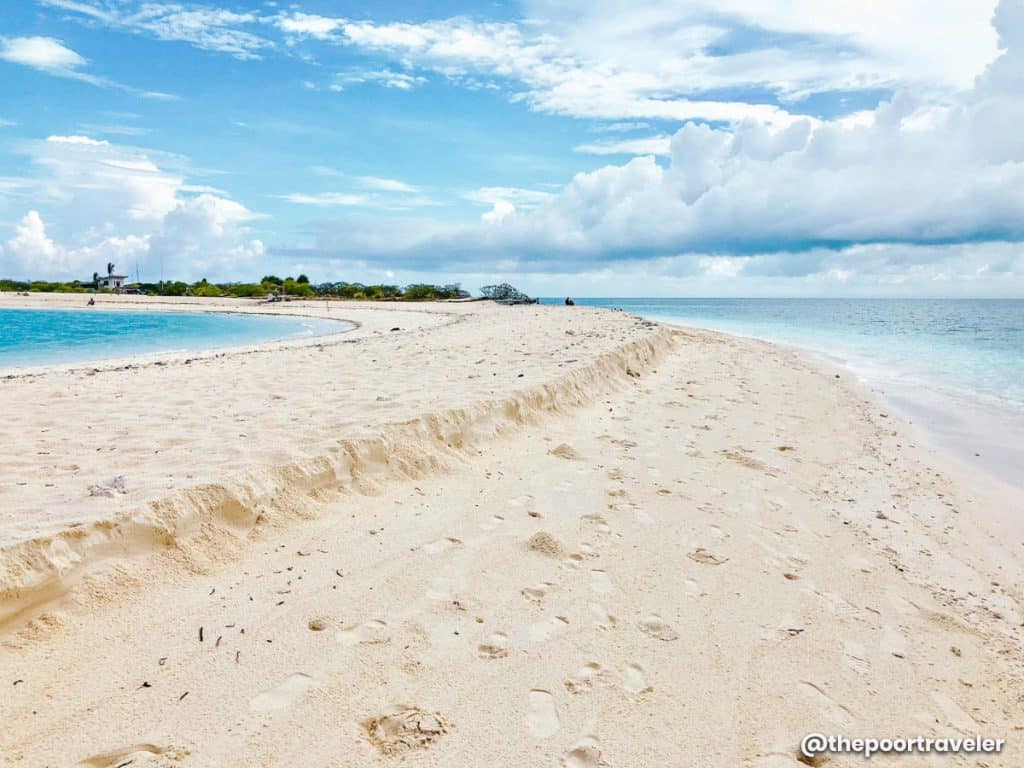
I have to warn you: getting to Seco Island can be a bit of a challenge. One, instead of a ferry or FastCat, you only have, as of writing, a large fishing vessel to transport you to the island from Tibiao. Two, the sea transit may take 2-3 hours, depending on the wave/sea condition. Three, you need to be up very early, like 2:00 AM. But the real warning is this: guard your heart. Seco Island will make you fall in love with its raw beauty. It broke my heart when it was time to leave.
From the Kinaray-a word meaning “elbow”, Seco Island was named as such because of its shape. The uninhabited 1.5km stretch of fine “polvoron-white” sand, enveloped by the varying shades of clear blue waters, is almost bare save for a few vegetation, concentrated on one side of the island. The island is perfect for kitesurfing and, well, beach-bumming! Camping used to be popular here, but since this is a Marine Protected Area, camping activities are regulated. For day trips, visitors need to leave after lunch as the current can get too strong going back to the mainland.
Jump-off Point: Tibiao, Antique
Best Time to Go: SummertimeKatahum Tours’ Seco Island Adventure Day Tour: P2,499+/person
(Minimum of five pax)
Inclusions: island adventure activities (swimming, exploring the island, boating), roundtrip boat ride (Tibiao mainland-Seco Island), hearty Antiqueño lunch on the island, cooler with ice and two gallons mineral water, Tibiao Bakery snacks, DOT-trained eco-guide, island guide, entrance fees, and free unlimited fish spa upon arrival on the mainlandNote: This is just one of the several tour packages that Katahum Tours offers for Seco Island Adventure experience.
MARARISON ISLAND
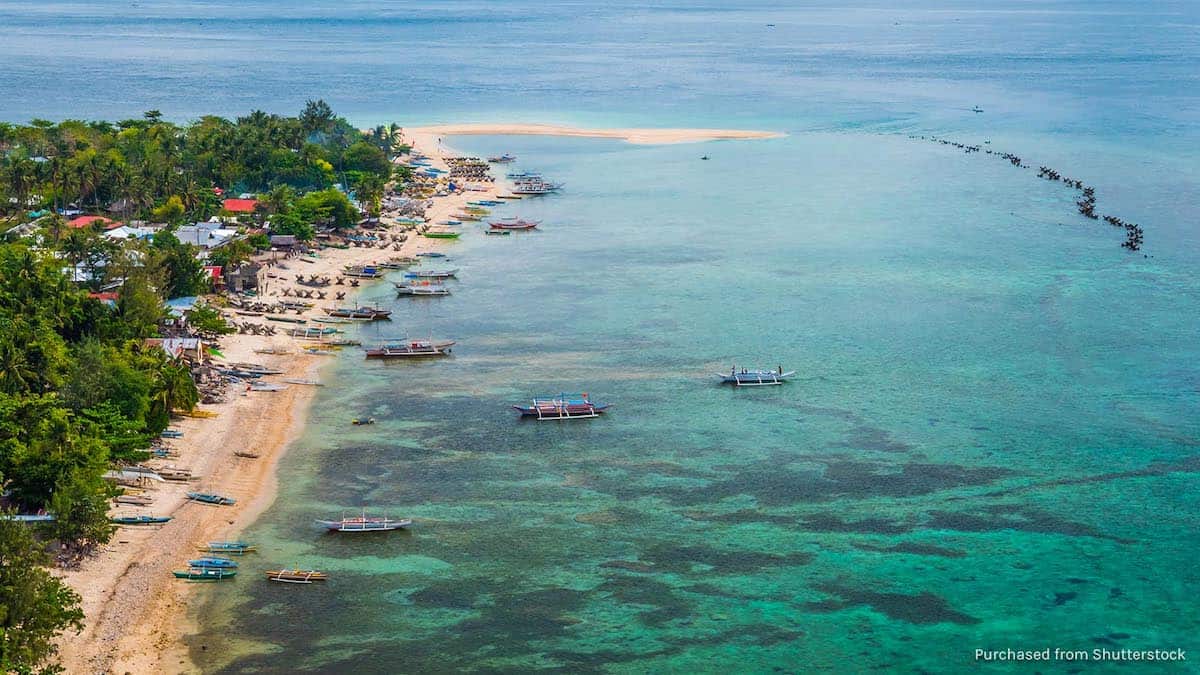
The town of Culasi is the jump-off point to Mararison Island (also called Malalison Island). It’s only a 15-minute boat ride from the mainland, so it’s very easy to get on the island. Mararison Island is best known for its Mararison Children’s Choir, welcoming visitors upon their arrival on the island. The children are local residents of the island. The beach where the boats usually dock has a sandbar, Kawit Sandbar, acting as a runway for beachgoers. This is also the side where most of the island folks reside. You need to register upon your arrival. You will find cottages that you can rent and snacks and drinks that you can buy from the small stores and stalls. Homestays and guesthouses are also available; most of them have basic/bare amenities. Better bring your own toiletries and towel.
Aside from the cream-colored sand of Kawit and Mayanan Beach, you can also explore the island by trekking along the trails snaking up and down the hills while also enjoying the idyllic view of the island and the Sulu Sea. The best spot to do this is at the Mararison Island viewpoint. Going further the other side of the island, you will find other beaches — Gitusan Beach and Luyo Beach. If you are into rock formations and caves, check out Gui-ob Cave and Nablag Islet on the opposite end of the island. We stayed at Enrique de Mararison located on this side of the island.
Environmental Fee: P20
Registration Fee: P20
Boat Rental: P750 (Roundtrip, good for 5 pax)
Trek Guide: P250 (maximum of 4 pax)
Cottage Rental: Starts at P300 (depends on size)Katahum Tours’ Mararison Island Adventures Day Tour: P2,249+/person
(Minimum of two pax)
Inclusions: island adventure activities (trekking, see the pitcher plants and other flora and fauna, exploring the mini-cave, crossing the islet of Nablag, swimming), roundtrip boat ride (Culasi-Mararison Island), native cottage or table for picnic, a hearty Antiqueño lunch by the beach, DOT-trained eco-guide, island guide, and entrance feesNote: This is just one of the several tour packages that Katahum Tours offers for Mararison Island Adventure experience.
MALUMPATI COLD SPRING
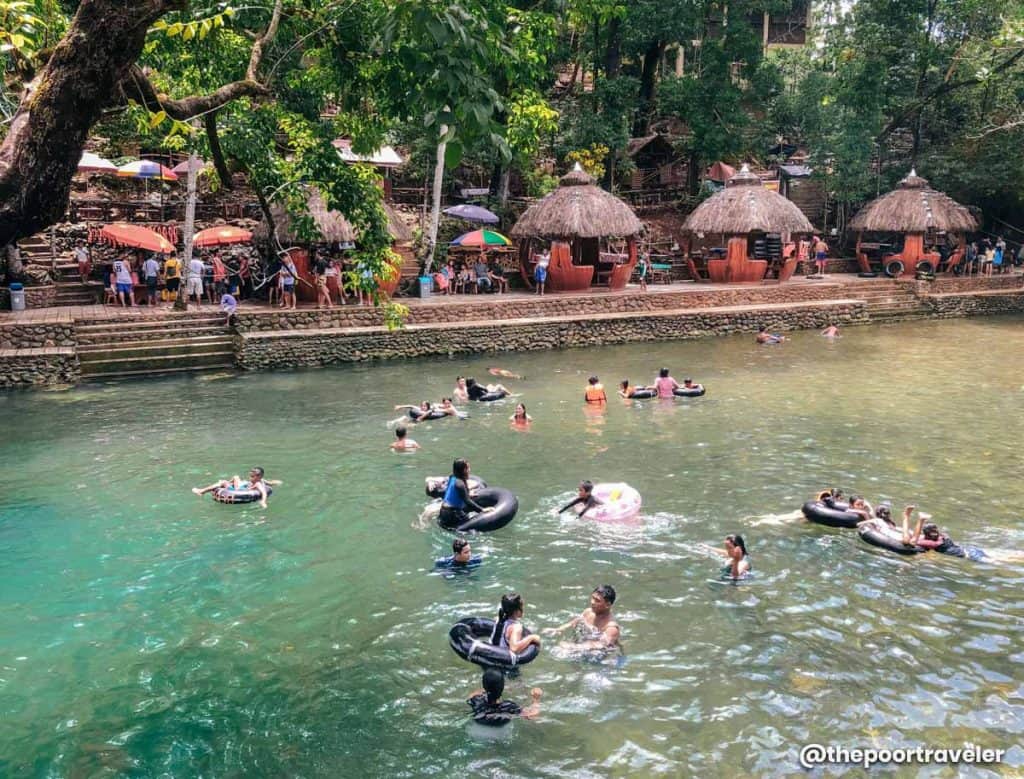
A Hall of Fame awardee, Bugang River is no stranger to being in the list of Philippine’s cleanest inland bodies of water. The river is located in Pandan, blessing the town with various kinds of eco-tourism activities and attractions such as the Malumpati Cold Spring. Pandan is just an hour drive from Caticlan Port; hence, most of the tourists are coming from Aklan (Boracay) to Malumpati as a side trip. The health spring’s main draw is its refreshing cool water, attracting residents and tourists alike, especially during summer. Other activities you can do aside from swimming are hiking, picnics, diving, and water tubing.
Opening Hours: 7:30 AM – 4:00 PM
Admission Fee: P40 for adults and P30 for senior citizens and PWDs (tourists) / P20 for adults and P15 for senior citizens and PWDs (residents) / P10 (children)
Accommodations: P200-500 (cottages) / P1200-1800 (overnight rooms)
Water Tubing: P200/person (includes tube, life vest, helmet, and guide)
Trek Guide: P200 (maximum of 5 pax per guide)Katahum Tours’ Malumpati Cold Spring Day Tour: P2,249+/person
(Minimum of 2 pax)
Inclusions: Eco-adventure (nature trek, swimming and river jumping, water tubing), native cottage or table for picnic, a heart Antiqueño lunch by the river, DOT-trained eco-guides, tour transportation within Pandan, and entrance feesNote: This is just one of the several tour packages that Katahum Tours offers for Malumpati Cold Spring experience.
NARANJO WATER PARK
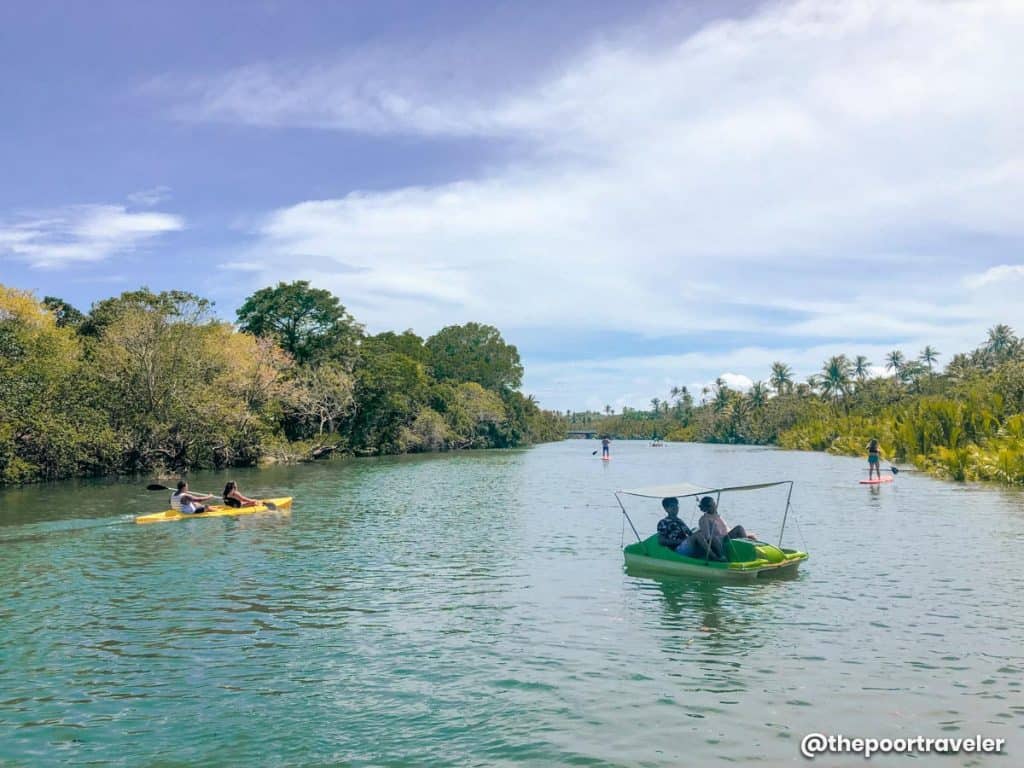
Another attraction along the Bugang River is the Naranjo Water Park, which is only a few minutes drive from Malumpati Cold Spring. For water activities, the water park offers kayak, stand up paddle board, pedal boat, and river cruise. If you just want to unwind and pamper yourself, kawa bath and fish spa are also available. The water park is also a favorite lunch stop for locals and tourists, providing a relaxing (and romantic) ambiance as you feast on the food.
Location: Sto. Rosario, Pandan, Antique
Pedal Boat: P350 per hour
Stand Up Paddle Board: P250 per hour / P500 (Half Day: 4hrs) / P800 (Whole Day: 8hrs)
Kayak: P250 per hour / P500 (Half Day: 4hrs) / P800 (Whole Day: 8hrs)
River Cruise: P80/person (minimum of 10 pax, maximum of 16 pax); 45 minutes (cruise duration)
Kawa Bath: P300 (2 pax, 30 minutes) / P400 (4 pax, 30 minutes)
Fish Spa: P100 per hour (adult) / P50 per hour (children, 12 y/o below)
DIOSO FARM
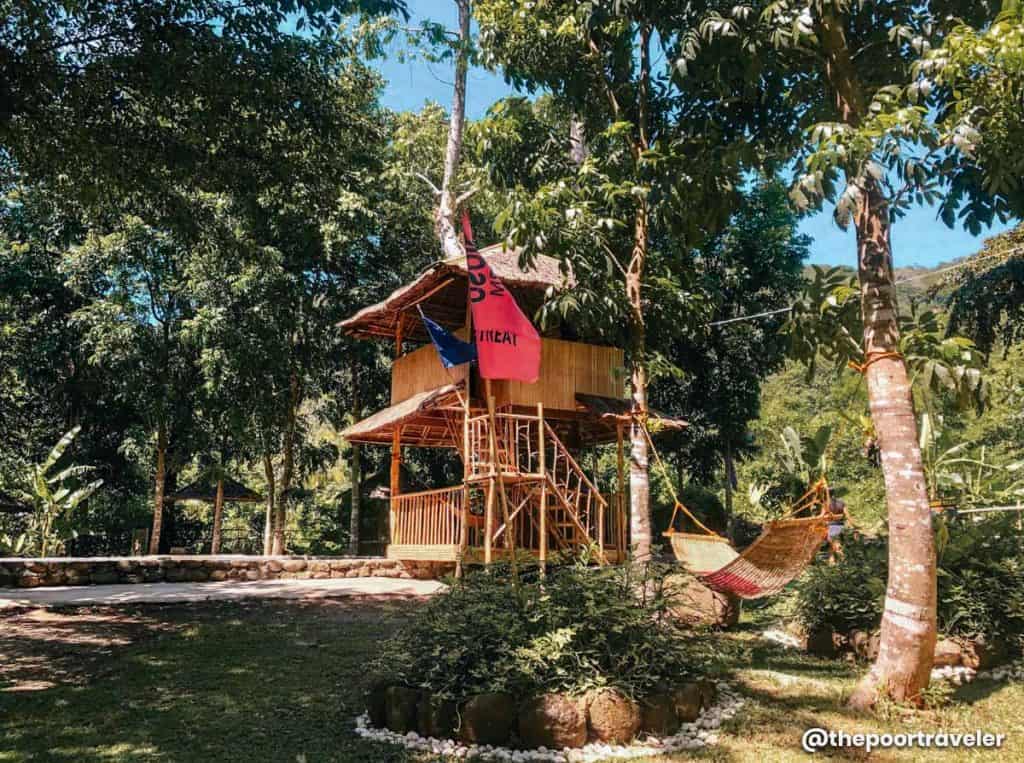
It has always been my dream to have a small farm near the mountains; one from where I can drive a short distance to get to the beach whenever I miss the saltwater and the balmy sea breeze. Dioso Farm embodies every bit of that dream. Upon entering the arch leading to the farm, it hit me, like a deja vu, and reminded me of that desire.
Dioso Farm and Mountain Spring Retreat is a little paradise in Pandan, Antique. This is another great getaway option while in town; it offers a more intimate encounter with nature as the management regulates the number of visitors per day. The quaint farm features a natural pool, kawa bath, a few cottages, several picnic tables, and overnight accommodations. But aside from promoting eco-tourism, the other thrust of the farm is to promote education as some proceeds of the fees collected are donated to the Antiqueños for Reading and the Leocadio Dioso Memorial Public Library in Pandan. If you want to book a day tour, Pandan Beach Resort can arrange it for you.
Contact Details:Pandan Beach Resort
Barangay Dionela, Pandan, Antique
Tel.No.: (036) 278 9379
Mobile No.: +63 917 580 9648
E-mail: pbrpandan@gmail.com
ANINGALAN HIGHLAND STRAWBERRY GARDEN
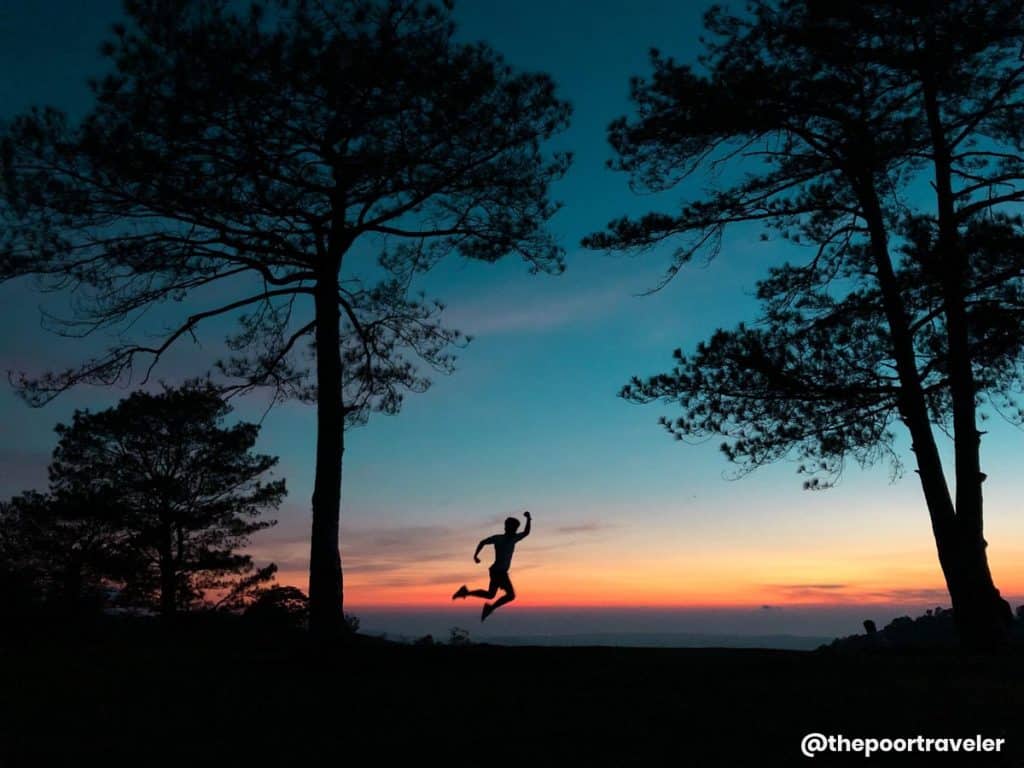
Yes, you read that right! There are strawberries in Antique too! Aningalan Highland Strawberry Garden is perched on the mountainous region in the town of San Remigio. The seedlings, thriving in the cool highland weather, come from Baguio and Benguet. You can go strawberry picking here with your family or friends when you visit during the right season, which starts as early as November and can last until April. If you visit during the off-peak season, the garden grows other vegetables and fruits. It also treats guests with colorful spectacle as different flowers bloom year round.
Other activities you can do here aside from fruit-picking and buying fresh produce and souvenirs are sunset-viewing, picnicking, hiking, mountain biking, and camping. If you are into trekking, not far from here is another interesting place to visit — Danao Lake. You can view the sunrise, ride a balsa (bamboo raft), and have a picnic.
Location: Barangay Aningalan, San Remigio, Antique
Opening Hours: 8:00 AM – 5:00 PM
Environmental Fee: P50/person
Entrance Fee: P50/person
IGBACLAG CAVE AND STONE CASTLE
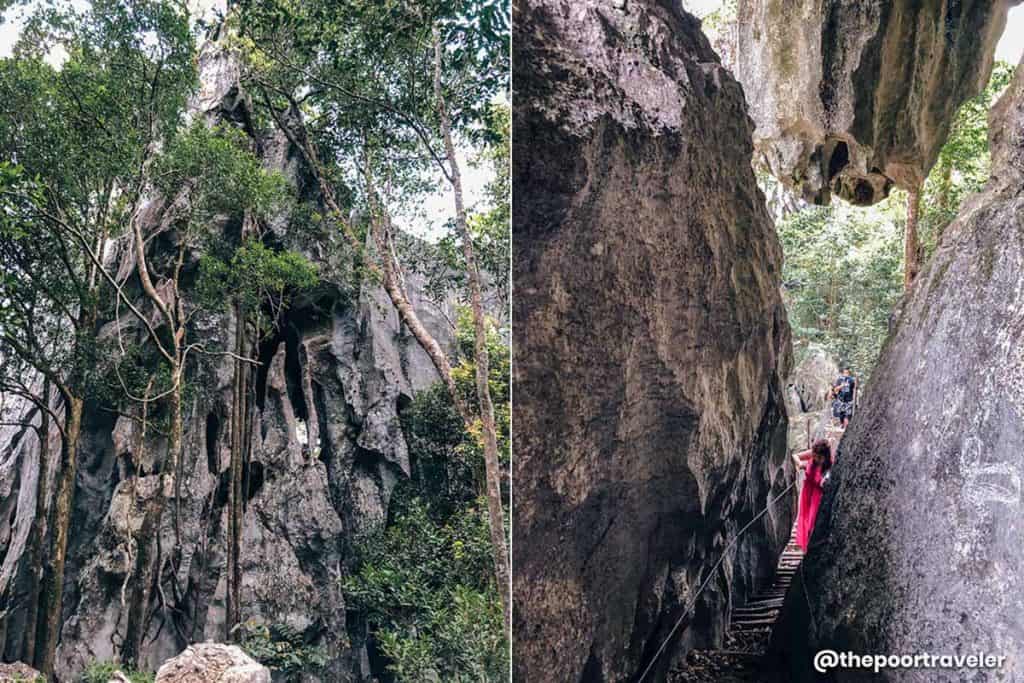
Igbaclag Cave is also located in Barangay Aningalan in San Remigio. On the outside, it looks like an imposing stone castle, hence the moniker. The cave is composed of two cave chambers with various openings. The bridge on the right side leads to a narrow entrance. After a few steps, you will reach the “balcony”. If you are up for the challenge, you can go cliff scrambling up the “terrace” where you will be rewarded with the panoramic view of the area. Note that the way up there can be really tough. Either that or just sashay your way to the exit and complete the caving in less than five minutes (sans the photo sessions). Also, if you are into botany, two species of Rafflesia, the biggest flower in the world, flourish around the area — Rafflesia lobota and Rafflesia speciosa.
Environmental Fee: P30/person
Guide Fee: P150-200 (maximum of 4 pax)
Note: The Rafflesia fully blooms during the rainy season and it only lasts 3-4 days.
ANTIQUE HERITAGE TOUR
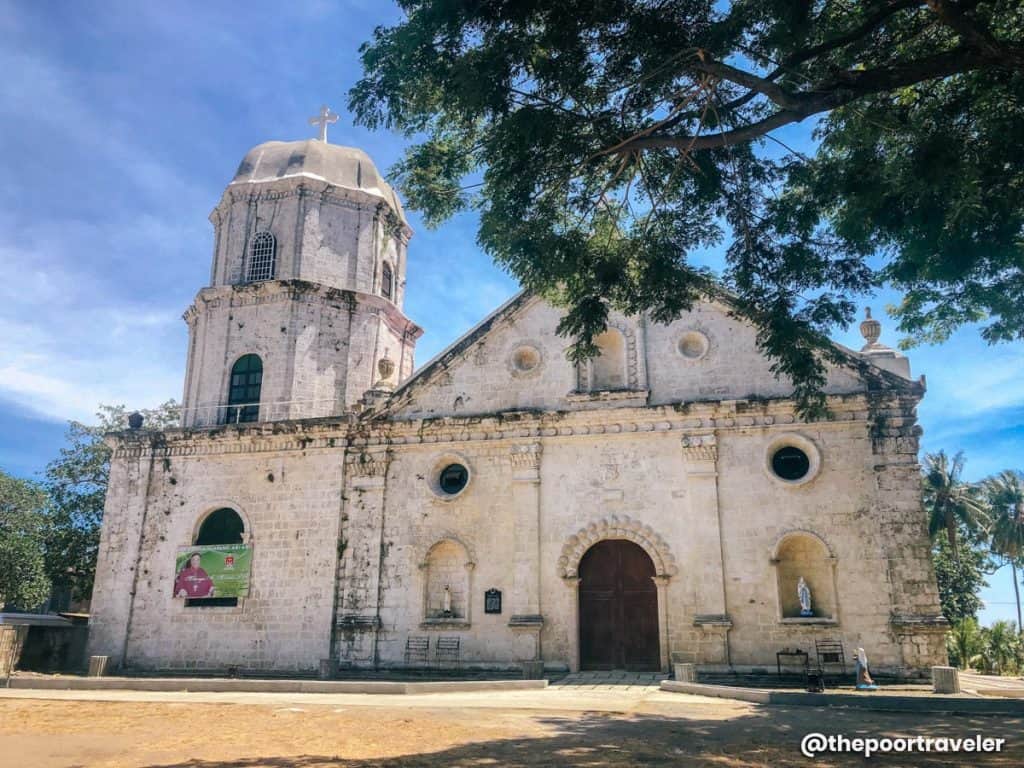
If the four provinces of Panay Island were sisters, Antique would be that silent sister who seems to keep things to herself, but when she does engage in conversations, she speaks volumes. Antique has a lot of stories to tell when it comes to history and heritage. Its age-old structures and historically significant events add colors to Antique’s mostly green and blue natural assets. Here are some of the historical landmarks and heritage sites (in “southern” Antique):
- Bantayog ng Wika. Located in San Jose de Buenavista, it is an imposing column installed at EBJ Freedom Park, immortalizing the native language, Kinaray-a, which is said to be the first to exist in Panay Island. The monument hails Antiqueños culture and identity through Kinaray-a language.
- Gen. Leandro Fullon National Shrine. Located at the plaza in front of Hamtic Municipal Hall, it honors Antique’s revolutionary commander during the Spanish colonial rule.
- Malandog River. Also located in the town of Hamtic, the river is said to be the site where the ten datus from Borneo first landed during the 13th century.
- Anini-y Church (St. John de Nepomuceno). Built in the 19th century, one of its interesting features is the archaic method of construction — using coral stones as building blocks and egg whites to bind them.
ALPAS
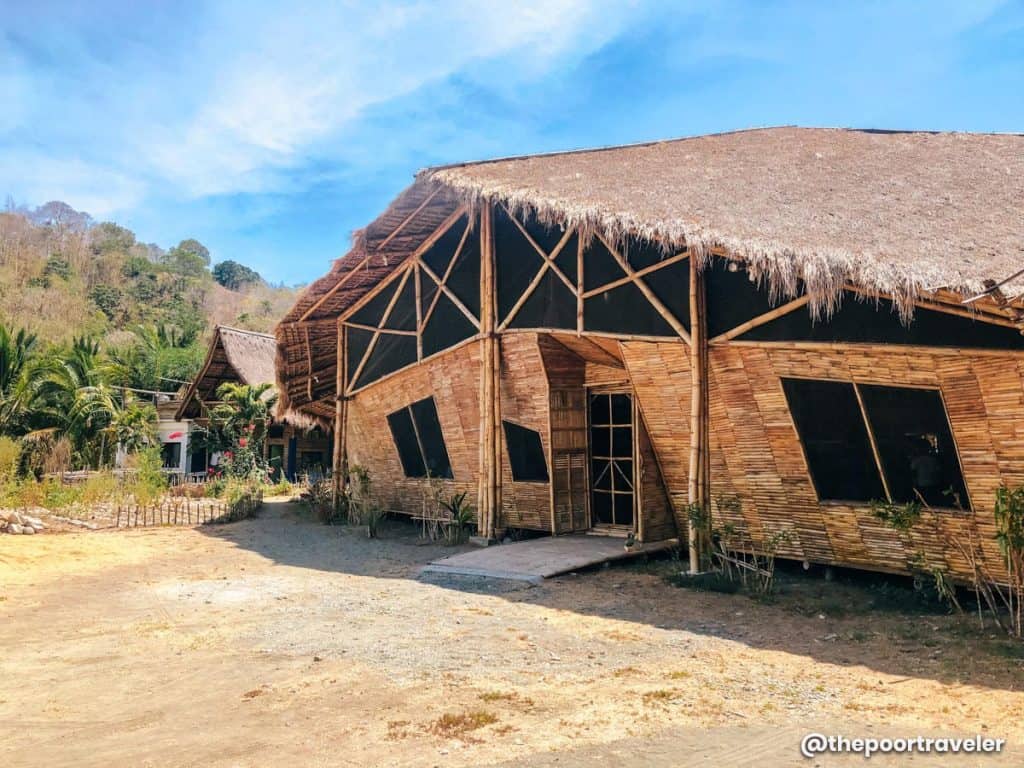
Alpas encompasses a restaurant, an organic garden, and guesthouse. It is ensconced between the national road and a beach in the town of Tobias Fornier (formerly Dao). The property got its name from the Tagalong word “alpas”, which means “to be free; to go beyond”.
The restaurant’s peculiar bamboo structure is conspicuous from the road, tickling the curiosity of travelers. The owners, Ken and Kim, aim to promote sustainability, sourcing all the ingredients (for the restaurant) and the materials (for the other products and services) locally. I personally enjoyed my time here. The restrooms are quite peculiar too! But I won’t tell you what made them unique; you have to experience it yourself. :p Alpas also offers cooking classes. Check the official website for details. Aside from the gastronomic brilliance, the property also features tranquil lodging spaces near the beach. Book and reserve through the website also.
Location: Sitio Ban Ban, Paciencia, Tobias Fornier, Antique
Opening Hours: 12:00 NN – 2:00 PM; 5:00 PM – 8:00 PM; Note: Closed on Mondays and Tuesdays.
Mobile No.: +63 939 358 2092
E-mail: alpasphere@gmail.com
Official Website: www.alpasph.com
Getting There: From San Jose, you can take the bus (P30) or a jeepney (P40). From Ceres Bus Terminal, board a Dao-bound bus. Just tell the conductor the address and the bus will drop you off in front of Alpas. If you opt to ride a jeep, go to Robinson’s Mall Jeepney Terminal and take the jeep bound for Casay or Anini-y. Taking the bus is recommended than the jeep.
NOGAS ISLAND
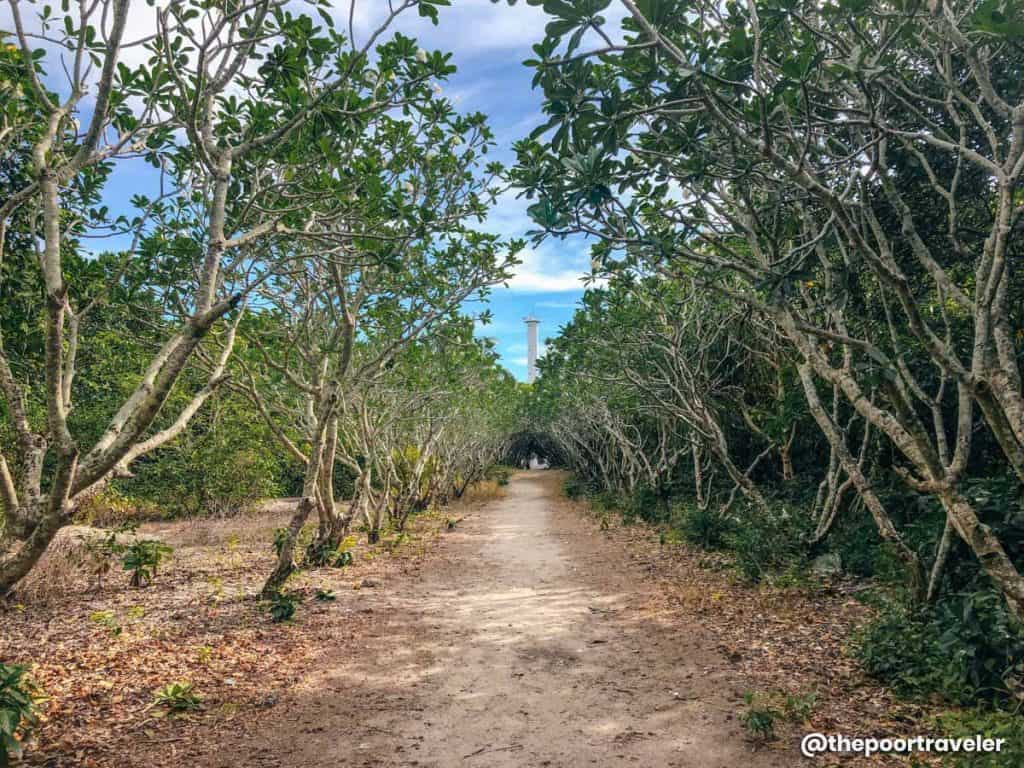
According to one of the many versions of oral folklore, Nogas Island emerged from where a commoner, Nogas, drowned. Nogas won the heart of a chieftain’s daughter, Anini-y. In order for him to marry her, he has to perform tasks. Nogas asked a mermaid (some say a fairy godmother) for help. They struck a deal but Nogas failed to do what he promised when he already got what he wanted from the mermaid.
Nogas Island is located about 4km off the shore of Anini-y. The island can be reached 15-20 minutes from the mainland. It is an uninhabited protected island. The 24-hectare (marine and bird) sanctuary features white-sand beaches, calachuchi tree “tunnel” (which leads to a lighthouse), a colossal balete (banyan) tree, and mangrove forest. The island’s surrounding waters are good for snorkeling and scuba diving.
Jump-Off Point: The usual jump off point is Sira-an Hot Spring
Boat Rental: Starts at 500 (good for 6 pax)
Environmental Fee: P20-50
Entrance Fee: P20-50
Getting There: From the town center of San Jose, take a jeepney to Anini-y. The fare is P60 (up to Sira-an Hot Spring).
SIRA-AN HOT SPRING
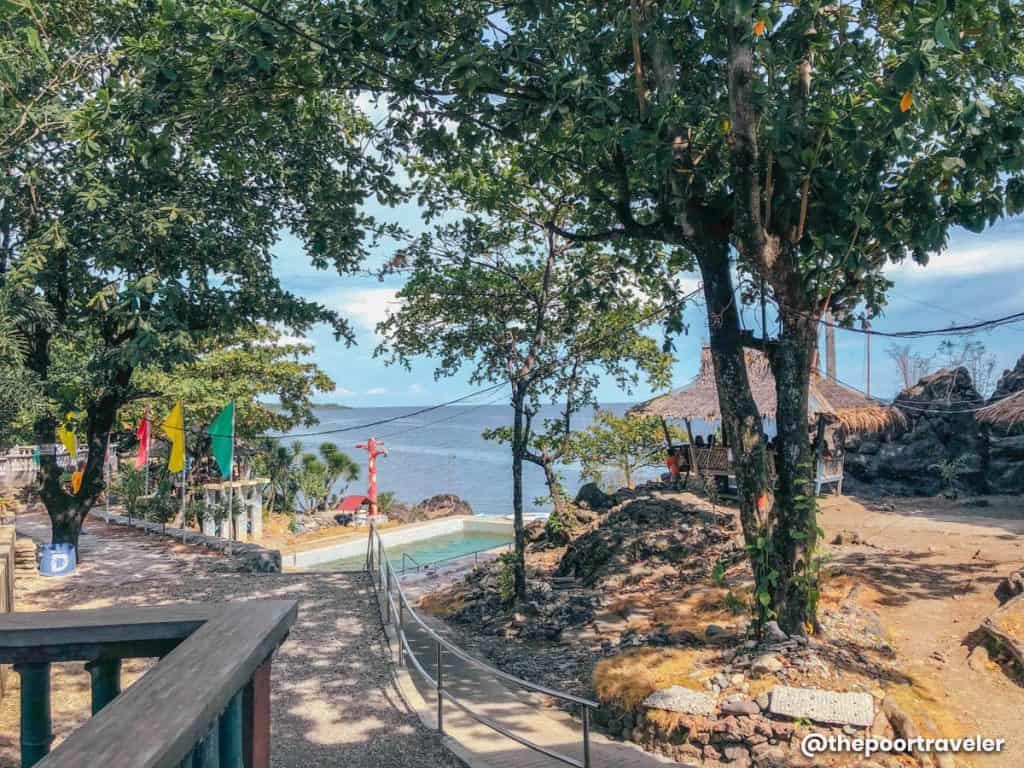
Surrounded by supernatural and mystical folk stories, Antique’s southernmost municipality, Anini-y, is far from being boring despite the very laidback atmosphere. Aside from the marine sanctuaries, rivers, mountains, and notable heritage sites, the town boasts a therapeutic sulfur hot spring located just along the seashore — the Sira-an Hot Spring. Local residents prefer to go there in the morning when they can enjoy the cool sea breeze while taking a relaxing dip in the hot tubs.
Entrance Fee: P100/person
Mobile No.: +63 929 295 0879
Getting There: From the town center of San Jose, take a jeepney to Anini-y. The fare is P60 (up to Sira-an Hot Spring).
These are just some of the many things to do and places to visit in the province. But hey! Exploring the whole of Antique is made easier now that Antique Airport relaunched. The province has become more accessible. And again, if you want a hassle-free trip, tour operators can handle your itinerary, land/sea transfers, and even food, depending on the package you choose.
Local Foods
As everyone suggests, if you visit a certain destination, eat like a local. Aside from knowing how the locals eat, the first thing to do is to discover where the locals eat. During my visit to Antique, I didn’t quite spot food chains which mean that there is a greater chance of existing eateries where the Antiqueños are loyal to.


Adobong pusit and river shrimps locally called as patuyaw.


Grilled blue marlin and the bean stew with banana pith.
I wish I just had a spoonful of everything, not a plate per serving. Another unexpected day in Antique was started with a simple yes when asked if we were interested to have a fresh buko juice at Everland Inn in Tibiao. We didn’t expect that it will be our ticket for a food-coma day trying out these food places.
Teren-teren of Tibiao Bakery
Tibiao Bakery has maintained to be consistent when it comes to bread and pastries that they have been considered a tradition in Antique. In fact, it already expanded into other parts not just of Visayas, but as well as in Luzon. They have a wide array of selections from loaf bread, pandesal, ensaimada, to their own creations such as the Ugoy-ugoy and Teren-teren. We really commend the Teren-teren that somewhat looks (and tastes) like the common Spanish bread but bigger, softer and “cheesier”. The bakery also serves pasta, palabok and burger with items all priced below Php 70.

Chicken Adobo of Floring’s Native Chicken
“Chicken Adobo is best at Floring’s Native Chicken,” shared by Ma’am Leah, a provincial tourism officer. Located at the south end of Cangaranan Bridge, the eatery preserves the traditional way of preparing the chicken dish. The owners make use of native chicken instead of the ones being sold at groceries because the first is more flavorful than the latter. The chicken will be cooked in its own oil with annatto seeds (atsuete) that makes the color of the dish orange. My verdict was, it has the same taste of the usual chicken adobo but has the hints of a chili pepper (siling labuyo) used to spice up the dish.

Bukotchoy of Dandansoy Restaurant
When you want to feel good and try some soup and noodles that will lighten you up, Dandansoy Restaurant is the place to be. At Php 35, you can enjoy the famous batchoy with a twist, served in a coconut shell. The media group coined a name perfect to market it, “bukotchoy”, buko with a batchoy. I thought the simple batchoy was only served inside a buko but I was thrilled when I found out that the soup has also coconut meat in it that added a sweet taste to the whole experience.

Binabak of Marquessa’s Bistro
For a little bit of fine dining, Marquessa’s Bistro of Pandan Beach Resort is the best fit to that. With its location fronting the Sulu Sea, dining at the restaurant will give you a relaxed and fancy ambiance with a cool music on the background. They will satisfy you with the appetizers, sizzlers, grilled, soups, pasta, sandwiches/burgers and salad you can order from their menu. We tried the buttered shrimp, grilled blue marlin, adobong pusit, cassava suman, bean stew and the Kinaray-a delicacy binabak. I enjoyed the binabak, which is made of pounded river shrimps locally called as patuyaw, young coconut meat and ginger, which is a fusion of all flavors.

With my enthusiasm to discover the food available in the province, I was able to try these restaurants that really kept the real taste and rich flavor of Antiqueño food. These places just mean that Antique doesn’t only offers heritage and adventure sites but also can be considered as a foodie destination.
Livelihood
Agriculture is the main industry in the province. Rice is particularly a primary crop. Antique has its own fishery, livestock, and poultry sectors. Its main products that are shipped out of the province to other centers in the country include rice, muscovado sugar, fruits and vegetables, copra and seaweeds. It also exports manufactured items and handicrafts. There are handful of mining facilities that exploit mineral resources in the province like marble, coal, gold, copper, gemstones, and limestones.
How to get to Antique
By air / land
Compared to its neighbors on Panay Island, Antique still remains a bit off the tourist radar. In 2019, Philippine Airlines (PAL) launched direct flights from Clark in Pampanga to San Jose de Buenavista, the capital town and main tourism center in the province.

- Via Aklan: Multiple airlines fly from Manila and other major hubs in the Philippines to Caticlan and the Kalibo International Airport in Aklan. From Kalibo, take a tricycle to the Kalibo bus terminal and ride a Ceres Bus to Antique. From Kalibo, buses ply the route to Pandan and San Jose de Buenavista. Travel time to Antique is 2-3 hours from Boracay or Kalibo.
- Via Iloilo: Multiple airlines fly from Manila and other major hubs in the Philippines to the Iloilo International Airport in Iloilo. From the airport, take a van to Molo Terminal (P50.00). Then take another van (P110.00) or jeepney to Antique. From Iloilo, buses and vans take two main roads: the mountain and coastal road. Travel time to Antique is 3-4 hours from Iloilo.
NOTE: The direct flight to Antique offers a faster entry point to those traveling to towns in Southern Iloilo including Miagao (home of the UNESCO World Heritage Site Miagao Church).
By sea
It’s also possible to get to Antique via land travel from Aklan (Caticlan) or Iloilo and by Roll-On Roll-Off Ferry from Manila via Caticlan. There are two major seaports in the province: the Lipata seaport in Culasi and San Jose seaport in the capital town.

Getting around town
Tricycles are the main mode of transportation in all towns of Antique. Buses and jeepneys provide service for inter-town travel. As of 2019, commercial motorcycle rentals are not yet available in the province, though they arrangements may be made with locals for rentals of their personal units.
Tour Operator: Katahum Tours

Because of the remote location and distance between tourist spots in different towns, it’s convenient to avail of package tours. Katahum Tours offers tours and van transport service for those who want a hassle-free way to get around. Katahum is a Visayan word that means beautiful. The tour operator specializes in eco-tours which advocates for sustainable management of natural resources, environmental education and the preservation of cultural treasures.
They offer various packages and can tailor-fit tours according to your needs. If you’re booking tours with them, please mention that you read about them on TRAVEL UP. 🙂
- Website: www.katahum.com
- Facebook: Katahum Tours
- Email: fate@katahum.com or katahumtoursantique@gmail.com
- Mobile: +63920 126 1205 (Smart) or +63917 450 3121 (Globe)
Video promotion:
Kruhay! Katahum kang Antique!


